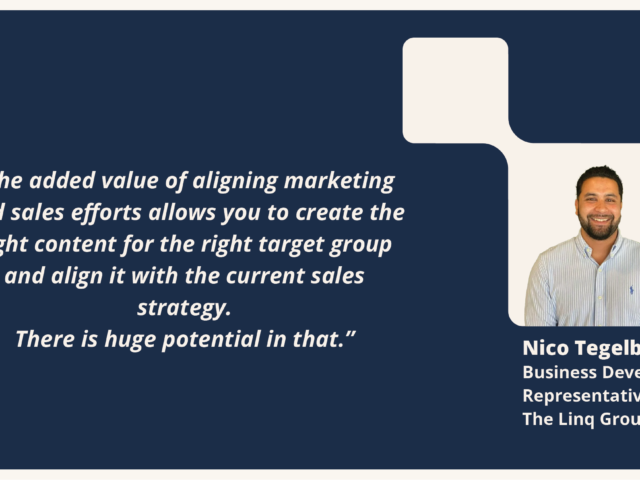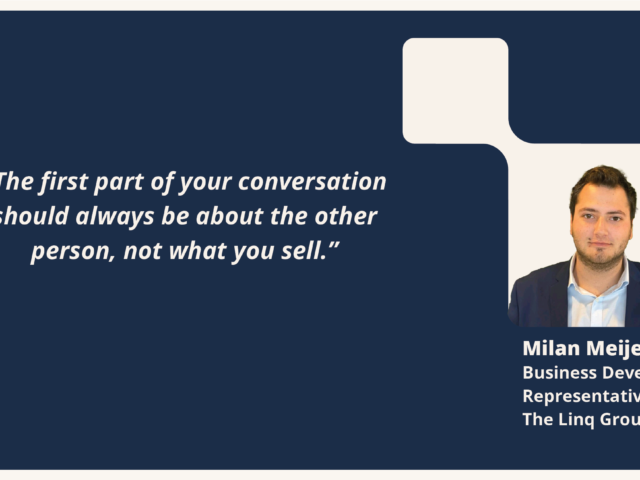How B2B Sales Enablement Enhances Communication between Marketing and Sales Teams

Introduction: What is Sales Enablement
Sales enablement makes sure that sales teams are equipped with the tools they need to close more deals. It includes marketing content, tech tools, training, data insights, and more. Especially in modern B2B sales, sales enablement can have a significant impact on your overall revenue.
Usually, the first impression a buyer gets of you is out of your hands, given that most prospects are well-informed before they even speak to a sales representative. And this is where sales enablement shines because it helps you to make these interactions matter.
Sales enablement helps sales reps present the right information to the right buyers at the right moment to drive opportunities further down the pipeline, close deals more efficiently, and drive business growth.
In this blog post, we’ll dive into how marketing and sales can align their efforts more closely to create an effective strategy that will help drive sales.
Table of contents:
- Why Sales Enablement is Important for B2B Sales
- The Role of Content in Sales Enablement
- Technology & Tools: Expanding Sales Enablement Efforts
- Measuring the Impact: Key Metrics to Track
- How to Build an Effective Sales Enablement Strategy: Tips and Best Practices
- Final thoughts
Why Sales Enablement is Important for B2B Sales
If you want to go fast, go alone. If you want to go far, go together. In order to achieve sales enablement, it is essential that marketing and sales departments work together and continuously communicate and support each other in reaching their shared goals.
Let’s look at some of the benefits that sales enablement can provide your teams:
Sales readiness: At its core, sales enablement in a B2B context is the strategic process of equipping sales teams with the tools, content, knowledge, and skills required to sell efficiently and improve overall sales productivity. It’s about ensuring that salespeople have the right resources at their fingertips—be it quality leads from marketing or important customer insights that will help them in their sales pitch.
Client-facing success: Everyone in customer-facing roles will benefit from relevant content, training, and coaching, including sales reps, customer success, service teams, and channel partners.
Improving buyer journeys: Sales enablement is a holistic approach involving strategy, processes, and technology. When sales enablement is effectively executed, it empowers sales teams to provide value at every stage of the buyer’s journey, bridging the gap between marketing’s efforts and sales’ closing strategies.
Sales enablement also allows your teams to:
- Empower every customer-facing team member to consistently engage in meaningful discussions with the right stakeholders at each phase of the customer’s decision-making journey, maximizing the ROI of the sales system.
- Have the most valuable and relevant content ready for each customer interaction
- Optimize sales processes and strategies to grow the pipeline
- Level up the sales team’s skills
- Help new team members be productive
- Incorporate insights and analytics to optimize sales tactics and content strategies
Sales enablement is very multifaceted – which means strategies and processes require the support of those working in and out of sales – specifically marketing and sales teams.
The Role of Content in Sales Enablement

Content like white papers, case studies, landing pages, blogs, and guides are what drive sales enablement. While marketing teams might create content with a broader audience in mind, sales enablement content zeros in on equipping the sales team with marketing assets that are specifically tailored to the unique needs and pain points of individual leads and prospects.
Here’s a more detailed look at the role content plays in sales enablement:
- Tailored buyer journeys: Different prospects have different pain points and requirements. Customized content addresses specific buyer personas, ensuring that the sales team has the right material to address varied client needs throughout their journey.
- Building credibility: High-quality, expert-driven content solidifies a company’s positioning in its industry. When a salesperson shares insightful content, it establishes them and the brand as thought leaders, fostering trust and rapport with potential clients.
- Nurturing leads: Not every lead is sales-ready. Content can be the nurturing tool that educates and engages leads, gradually moving them down the sales funnel. From high-value blog posts to relevant whitepapers, content can answer questions and address concerns, making leads more receptive to sales pitches.
- Training sales teams: Content isn’t only external-facing. Internal content, like training modules, best practice guides, and product deep dives, ensures that sales teams are always up-to-date with the latest product or service knowledge.
- Addressing pain points: A well-kept content library allows sales representatives to promptly respond to client concerns. Whether it’s a case study showcasing success or a detailed product guide, having content on hand can make a difference in closing a deal.
- Feedback loop: Content creation should be dynamic. Sales teams, being on the front lines, can provide valuable feedback on what content resonates with clients. This feedback loop ensures that the content strategy evolves and remains relevant.
- Promoting consistency: A unified content strategy ensures that all sales representatives are on the same page, delivering consistent brand messages. This uniformity is crucial in establishing a strong brand image and promise.
In essence, content fuels sales enablement by equipping sales teams with the tools they need, facilitating meaningful interactions with leads, and strengthening the brand’s reputation.
Technology & Tools: Expanding Sales Enablement Efforts

With easy access to advanced technology, sales enablement has transformed significantly. The right tool stack allows teams to streamline processes and foster better alignment, more personalized outreach, and improved results.
Let’s look at three of the most important tech tools for sales enablement:
- CRM integration: The heart of modern sales and marketing is a robust CRM system. This tool does more than just store client information:
- Unified view: Allows sales reps to have a comprehensive overview of a prospect’s interactions, from website visits to email responses and beyond.
- Personalization at scale: Use data points to tailor interactions, ensuring each outreach feels personal and relevant.
- Data-driven insights: Unearth trends, recognize opportunities, and pinpoint areas of improvement.
- Content libraries & management: It’s essential to have a central archive for all marketing content that can be relevant to your sales team.
- Accessibility: Ensures that sales reps can quickly find and share the right content for any situation.
- Version control: Keep content updated, ensuring reps always use the most recent and relevant material.
- Engagement metrics: Monitor which content assets resonate most with prospects, allowing for data-driven content strategy refinements.
- Performance analytics & automation: Beyond just tracking metrics, advanced analytics tools can offer actionable insights.
- Lead scoring: Prioritize prospects based on interactions, ensuring sales teams focus on the most promising leads.
- Automation: From sending follow-up emails to scheduling calls, automate repetitive tasks, allowing sales reps to focus more on relationship-building.
- Feedback loop: Continuous feedback between sales and marketing ensures that content is always evolving based on what truly works in the field.
How to Build an Effective Sales Enablement Strategy: Tips and Best Practices

Crafting a sales enablement strategy that consistently delivers results can be very intricate.
So we have put together some expert-approved guidelines to help you create a sales enablement strategy that will help you drive sales:
Start with clear objectives: Before diving into tactics, clearly define what you aim to achieve. Do you want to reduce the length of your sales cycle, increase conversion rates, or improve cross-team collaboration? Your objectives will dictate the resources and tactics you prioritize.
Align sales and marketing: Alignment isn’t just about communication. Both teams need to intersect in their work processes frequently to make sure they are working towards common objectives and KPIs, like conversion rates or lead value. This promotes collaboration and ensures a consistent message across all touchpoints.
Here are strategies to consider when working on aligning sales and marketing teams:
- Teams discuss what marketing materials are needed per sales stage
- Weekly sales and marketing meetings to review results and make adjustments
- Marketing shadows sales calls to learn more about prospect challenges, needs, and objections and address them in their content strategy.
- Teams share reporting and analysis and give each other feedback and share learnings
- And, of course, celebrate each other’s wins.
Craft buyer personas: A buyer persona is a detailed representation of your ideal customer, and it goes beyond just demographics. It allows you to get to know your audience inside out and can guide content creation, ensuring resources address actual pain points and questions your prospects have.
- Deep dive interviews: Interact with existing clients to understand their challenges, motivations, buying patterns, and content consumption habits.
- Segmentation: One size doesn’t fit all. Differentiate between personas based on their roles, industries, company sizes, and even regional nuances.
- Update regularly: Business challenges and priorities evolve. Revisit and refine personas at least annually or after any significant market shifts.
Optimize content for sales stages: Every piece of content should cater to a specific stage in the buyer’s journey. Whether it’s an introductory blog post, a detailed whitepaper, or a post-sale tutorial, ensure content is tailored to where the prospect is in the sales cycle.
- Awareness stage: Content here should educate potential buyers. Think blog posts addressing industry challenges, infographics, and introductory webinars.
- Consideration stage: Prospects are evaluating solutions here. Offer comparison charts, case studies, and expert guides.
- Decision stage: This is where detailed product demos, customer testimonials, and ROI calculators can make all the difference.

Feedback is gold: Regularly collect feedback from the sales team. They’re on the frontline and can offer valuable insights into what’s resonating with prospects and where there might be gaps.
- Regular check-ins: Don’t wait for quarterly reviews. Have short, frequent check-ins with the sales team to understand their challenges and needs.
- Feedback loop: Create a structured mechanism where sales can offer feedback on content – what’s working, what’s not, and input on ways to improve or maximize success rate.
- Act on it: Simply collecting feedback isn’t enough. Show the sales team that their inputs are valued by acting on their feedback and making necessary adjustments.
Adopt a multi-channel approach: While direct meetings are still important, today’s B2B buyers are active on multiple channels. Ensure your sales enablement strategy includes strategies like social selling and email outreach.
- Social selling: Especially on platforms like LinkedIn, where B2B decision-makers spend a significant amount of time. Equip your sales team with content tailored for social sharing – be it bite-sized videos, infographics, or insightful articles.
- Email outreach: Despite the buzz around newer channels, email remains an important tool. But generic bulk messages rarely deliver the results you are looking for. Train the sales team on crafting personalized, value-driven emails.
Final Thoughts
When integrated effectively, these tools become the backbone of a successful sales enablement strategy. Through this integration, sales and marketing can align their efforts more closely, ensuring seamless communication and data sharing.
It also empowers the sales team to make data-driven decisions, optimizing their strategies based on what truly resonates with prospects.












